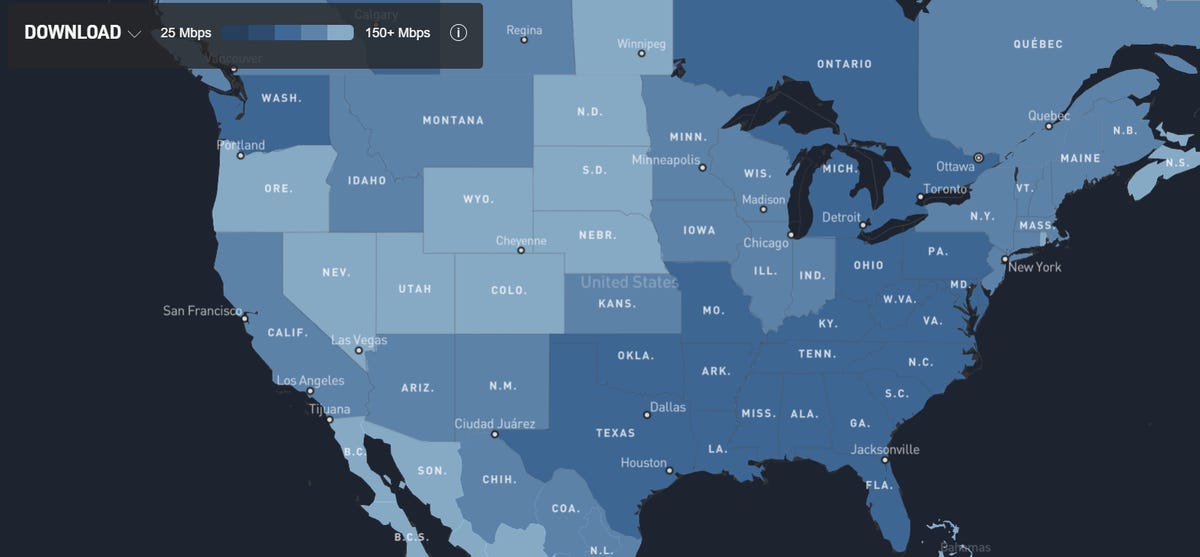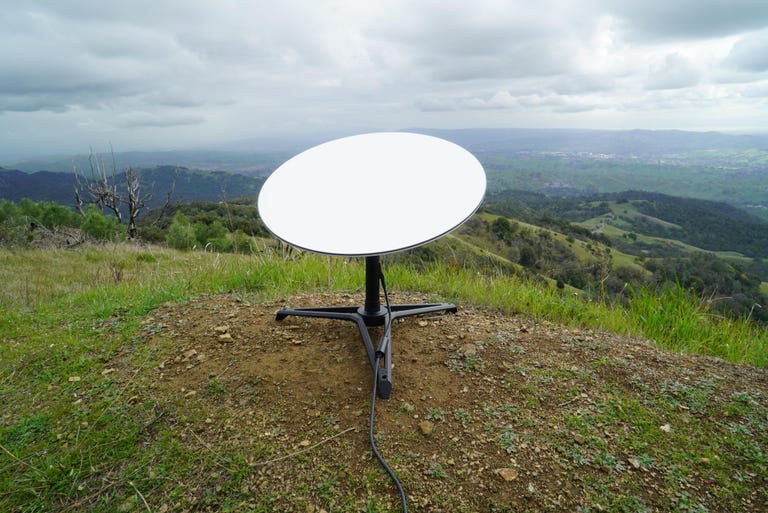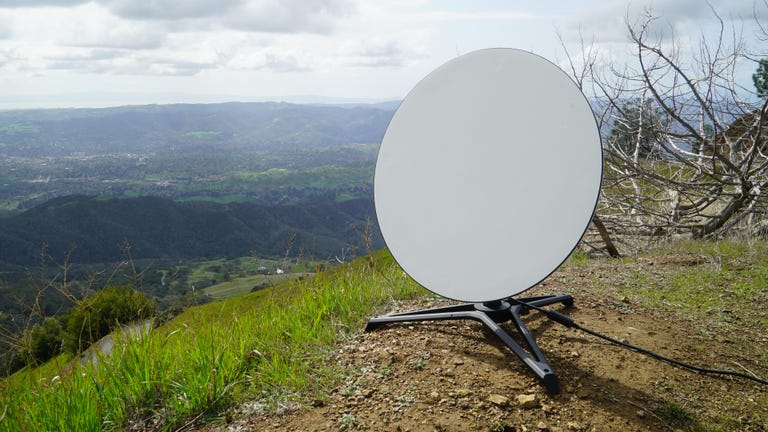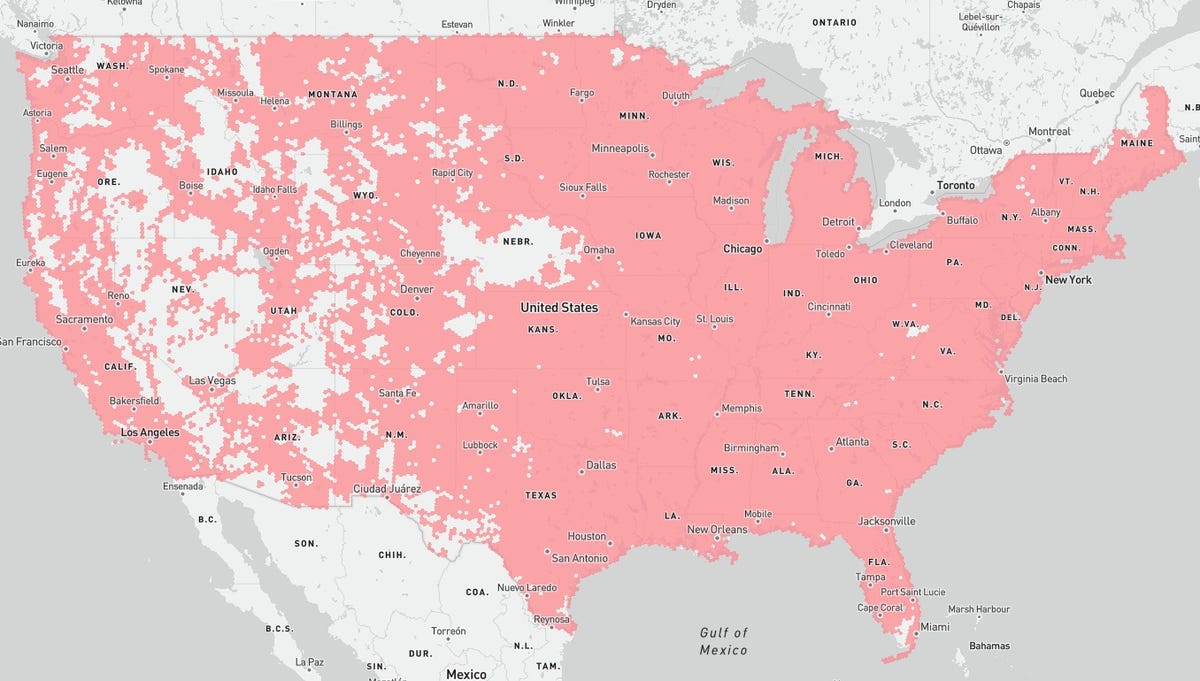Is Starlink or T-Mobile Home Internet better?
Starlink and T-Mobile Home Internet are closely matched when it comes to expected speed ranges, latency and unlimited data. T-Mobile Home Internet is going to be cheaper both upfront and month to month, however, giving the 5G internet provider a significant advantage over Starlink.
That said, it doesn’t matter how good or affordable an ISP is if it isn’t available at your address. That’s where Starlink comes in. The low-orbit satellite service is there to fill the broadband gap where T-Mobile Home Internet is unavailable and other rural internet options, such as DSL and geostationary satellite (Hughesnet, Viasat), are less desirable.
CNET’s individual reviews of each provider further that notion. T-Mobile Home Internet scored a 7.4 out of 10, one of the highest ratings out of all 40-plus ISPs CNET has reviewed (Verizon Fios has the best overall score at 7.6). Starlink, on the other hand, earned a 6.5, well below T-Mobile Home Internet but still higher than competing satellite internet providers Hughesnet (6) and Viasat (6.1).
How else do Starlink and T-Mobile Home Internet compare, and which service is ultimately the best for your home? You’ll find everything you need to know about Starlink versus T-Mobile Home Internet below.
Our take – Starlink mostly overcomes the speed, data and latency limitations satellite internet is notorious for, but not the sky-high costs. Service starts at $120 per month, but it will cost you $299 or higher in equipment fees just to get started.

Our take – The simple plan and pricing structure make T-Mobile Home Internet an ideal option for internet in rural areas where choices are limited or as an alternative to big cable and fiber providers in larger cities.
Starlink vs. T-Mobile Home Internet plans
Starlink offers a few plan options, but fixed home internet service will come down whether you want Standard or Priority data. Standard is the cheapest option at around $120 a month for expected speeds ranging from 25 to 100 megabits per second. Priority service offers a higher, more consistent, upload and download speed range (40 to 220Mbps), at least until you’ve reached the data limit. After that, your service is bumped to Standard for the remainder of the billing cycle.
T-Mobile Home Internet has two versions of the same home internet plan, plus a new roaming plan. If you’re just interested in home internet, T-Mobile Home is half the price of Starlink’s cheapest plan (and even cheaper for qualifying T-Mobile voice customers) and has a higher speed range. Here’s a look at each provider’s plans.
Starlink internet plan details
| Starlink plan | Monthly price | Download speed range | Upload speed range | Equipment costs | Data allotment | Contract |
|---|---|---|---|---|---|---|
| Standard | $120 | 25-100Mbps | 5-10Mbps | $299-$499 upfront | Standard unlimited | None |
| Priority | $140-$500 | 45-220Mbps | 8-25Mbps | $2,500 upfront | 40GB-2TB, standard unlimited thereafter | None |
| Mobile | $50-$150 | 5-50Mbps | 2-10Mbps | $299-$499 upfront | Standard unlimited | None |
| Mobile Priority | $250-$5,000 | 40-220Mbps | 8-25Mbps | $2,500 upfront | 50GB-5TB, standard unlimited thereafter | None |
Show more (0 item)
T-Mobile Home Internet plan details
| T-Mobile plan | Monthly price | Download speed range | Upload speed range | Equipment costs | Data cap | Contract |
|---|---|---|---|---|---|---|
| Home Internet | $50-$60 ($40 or $50 with qualifying mobile plan) | 72-245Mbps | 15-31Mbps | None | None | None |
| Home Internet Plus | $70 ($60 with qualifying mobile plan) | 72-245Mbps | 15-31Mbps | None | None | None |
| Internet Away | $110-160 ($40 or $50 with qualifying mobile plan) | 72-245Mbps | 15-31Mbps | None | 200GB or unlimited | None |
Show more (0 item)
Starlink vs. T-Mobile Home Internet pricing
As mentioned above, T-Mobile Home Internet is half the cost of Starlink’s cheapest plan, starting at $50 per month ($60 in select areas) compared with $120 with Starlink Standard. A $10 discount is available to qualifying T-Mobile voice customers, bringing the monthly rate down even further.
There are no set price increases with T-Mobile Home Internet, and the provider is currently running a unique “price lock,” offering to pay your final bill if the monthly rate ever increases.
Likewise, there are no set price increases with Starlink, but the monthly home internet rate has fluctuated in the short time since service has been available (in fairness, T-Mobile Home Internet rates have shifted between $50 and $60 multiple times). Starlink’s cheapest plan, and probably the most suitable for everyday home internet use, runs $120 per month.
For a priority data connection with a faster speed range and better speed consistency during periods of network congestion, Starlink home internet will run you $140 to $500 per month depending on your chosen data allotment of 40GB, 1TB or 2TB.

Starlink vs. T-Mobile Home Internet speeds
Starlink and T-Mobile Home Internet plans advertise an expected speed range, meaning the maximum speeds a home receives will vary based on location, network congestion and other factors. T-Mobile Home Internet’s speed range is higher than Starlink (72 to 245Mbps versus 25 to 100 or 40 to 220Mbps with Starlink), but that doesn’t guarantee it to be the faster provider.
T-Mobile Home Internet estimates that “25% of our customers see speeds below and 25% see speeds above” the 72 to 245Mbps range, according to the provider’s FAQ page. The speeds you get with T-Mobile Home Internet will depend on your proximity to a mobile tower and the number of nearby customers who rely on the T-Mobile network for home internet and contribute to network congestion. In some cases, T-Mobile will lean on its 4G LTE network to deliver home internet, which can result in speeds slower than the advertised speed range.
Starlink says that “a majority of customers [experience] speeds over 100Mbps.” Like with T-Mobile Home Internet, Starlink’s available speeds will vary by location and network congestion, but Starlink is more transparent about what speeds you can expect in different parts of the US (displayed in the map above). As more satellites join the Starlink fleet — there have been 27 Starlink launches so far in 2024 — maximum available speeds, and resistance to network congestion, could continue to improve.
Starlink’s priority data could come in handy
Those with priority data are less vulnerable to slowed speeds during periods of high activity. Starlink’s Fair Use Policy states, “Priority data is given network precedence over Standard and Mobile data, meaning users will experience faster and more consistent download and upload speeds.”
T-Mobile Home Internet doesn’t offer standard versus priority service tiers, so everyone is at the same mercy of the network’s capacity and capabilities.
What about latency?
Latency, or the time it takes your connection to send data back and forth, is notoriously high with traditional, geostationary satellite internet services, rendering online gaming next to impossible.
Starlink and its network of low-orbiting satellites drastically reduce the time it takes to send data from the sky to your home and back. Advertised latency for Starlink internet is between 25 and 60 milliseconds, a significant improvement over Hughesnet or Viasat (which can hit 400 ms or higher) and low enough to support online gaming.
T-Mobile Home Internet signals have a shorter distance to travel, and as a result, expected latency ranges are lower than Starlink at 19 to 37 ms (24 to 40 when relying on its 4G LTE network).
Still, latency from either provider is low enough that you likely wouldn’t notice a difference between Starlink and T-Mobile Home Internet. Both ISPs have a latency range that will comfortably support online gaming, so don’t let latency influence your decision too much on Starlink versus T-Mobile Home Internet.
Starlink vs. T-Mobile Home Internet equipment and fees
Speeds and latency are a toss-up between Starlink and T-Mobile Home Internet, but the latter has a clear advantage when it comes to equipment and accompanying fees.
There are no equipment fees, upfront or ongoing, with T-Mobile Home Internet. Your equipment arrives with free, two-day shipping and setup is simple — just plug in your router, then create your Wi-Fi network (and don’t forget to take these steps to secure it).

Starlink recently lowered its equipment purchase fee to $299 in select locations, but it’s still $499 in others. Equipment fees are due at the time of your order.
Refurbished equipment may be available for around $400, but that’s still a huge upfront cost compared with T-Mobile Home Internet. On top of that, a shipping and handling fee of around $20 may apply.
Despite the shipping fee, it will probably take longer to get your equipment than T-Mobile Home Internet — up to two weeks. The setup appears to be fairly straightforward (check it out in the video below), but it’s still going to be more involved than T-Mobile Home Internet.

Watch this: Testing Out SpaceX Starlink Satellite Internet
No data caps or contracts with either service
Nothing really to move the needle one way or the other here. Neither provider enforces data caps or requires a contract for service.
Granted, Starlink has its Priority plan with varying amounts of data, but there is still no cap on your total usage. Once the priority data pool is depleted, customers fall to the Standard (and still unlimited) data plan.
Starlink vs. T-Mobile Home Internet availability
Choosing an internet provider starts with what’s available in your area. Starlink has the availability advantage over T-Mobile Home Internet and basically every other nonsatellite provider.
According to the most recent FCC data, Starlink is available to 99.6% of US households. While a few pockets across the US aren’t yet serviceable for Starlink, the biggest areas that lack availability are in west-central New Mexico and along the Virginia-West Virginia border. For the most part, Starlink is immediately available everywhere else.

T-Mobile Home Internet’s availability has rapidly increased, and there’s no reason to expect the ISP will slow down anytime soon. Still, nationwide availability sits at just under 60% as of December 2023, per the most recent FCC data. Coverage is particularly low in the western states of Nevada, Oregon, Utah and Wyoming — states where Starlink indicates its fastest speeds are available.
Even in areas largely serviceable for T-Mobile Home Internet, availability can vary by address and the current network capacity. As a result, home internet service may not be available, even if you can get 5G on your phone.
Starlink vs. T-Mobile roaming internet
Along the lines of availability, Starlink also offers Mobility internet service intended for “RVs, nomads and campers” that allows you to take your internet connection essentially anywhere. Service starts at $50 to $150 a month for standard unlimited data while priority data plans range from $250 to $5,000.
T-Mobile Home Internet recently launched a roaming plan of its own, T-Mobile Home Internet Away. At $110 a month for 200GB or $160 for unlimited data, the monthly rate is more in line with Starlink, although going with T-Mobile will save you a good bit on equipment costs.
Starlink vs. T-Mobile Home Internet customer satisfaction

Both providers are fairly new to the home internet market, so there’s limited historical data tracking customer satisfaction trends from Starlink or T-Mobile Home Internet. Both providers seem to be off to a good start.
In its third year to include T-Mobile Home Internet in its annual report and second year to distinguish fiber from nonfiber providers, the American Customer Satisfaction Index gave the ISP a score of 76 out of 100. The score, a three-point increase year over year, was well above the average for nonfiber providers (68) and T-Mobile took the top spot in the category.
Starlink isn’t included in ACSI data, but an Ookla Speedtest Intelligence report from the first quarter of 2023 gives insight into customer reception and satisfaction. Data from the report shows that Starlink had a significantly higher Net Promoter Score (a study of how likely a customer is to recommend a service) than the averaged score from all other ISPs despite having slower median download speeds. Starlink outperformed other ISPs exceptionally well in nonmetropolitan settings, which makes sense as the service is geared toward rural internet users.
Starlink vs. T-Mobile Home Internet recap
Since entering the broadband space, Starlink and T-Mobile Home Internet have improved high-speed availability and connectivity, particularly in areas where options have long been (and still are) highly limited.
While both providers provide significant upgrades in speed and reliability compared with other rural internet services, T-Mobile Home Internet would be my preferred choice if given the option of the two. T-Mobile Home Internet is considerably cheaper than Starlink, upfront and month to month, while service is potentially faster and easier to get started.
T-Mobile Home Internet isn’t available everywhere. In areas where T-Mobile Home Internet doesn’t yet reach, Starlink is likely to be the best option for high-speed internet compared with geostationary satellite internet (Hughesnet, Viasat) or DSL internet.
Starlink vs. T-Mobile Home Internet FAQs
Is Starlink or T-Mobile Home Internet better?
Starlink and T-Mobile Home Internet match up fairly evenly regarding speed, data caps and contracts. Starlink’s main advantage over T-Mobile Home Internet is availability, as the satellite ISP is available nationwide, whereas T-Mobile Home Internet currently covers just over half of US households.
Where both providers are available, T-Mobile Home Internet will be the cheaper option. Service starts at half the cost of Starlink’s cheapest plan, and there are no equipment fees, saving customers $299 to $499 or more in upfront costs compared with Starlink.
Is Starlink or T-Mobile Home Internet faster?
Starlink’s fixed home internet advertises a speed range of 25 to 100Mbps or 45 to 220Mbps, depending on your chosen service tier. T-Mobile Home Internet has a slightly faster download speed range, 72 to 245Mbps.
Location, network congestion and other factors impact actual speeds from both providers, so Starlink may be faster in some locations while T-Mobile Home Internet is faster in others.
Starlink’s Priority plan could deliver faster speeds and better reliability by giving users network precedence over Standard users, eliminating or mitigating slowed speeds due to network congestion. T-Mobile Home Internet doesn’t offer a similar service tier, so customers may be more likely to experience speed issues during peak usage times or in areas with many users relying on the network.
Does T-Mobile use Starlink for internet?
Does bad weather affect Starlink or T-Mobile Home Internet?
Starlink and T-Mobile Home Internet are less susceptible to service disruptions due to bad weather than traditional, geostationary satellite internet service. Still, heavy cloud coverage, rain or other severe weather conditions can interfere with Starlink signals. Additionally, snow or ice accumulation on the satellite dish could impact service.
Internet signals from T-Mobile Home Internet have a shorter distance to travel and are far less susceptible to service disruptions during bouts of bad weather.





